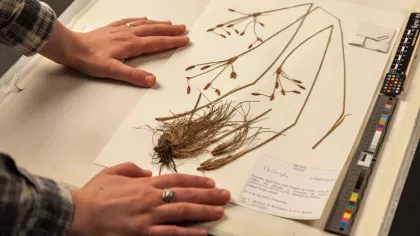Global Plants Initiative (GPI)
Increasing access to nomenclatural type specimens held in herbaria across the world through digitisation.

The programme began in 2004 as the African Plants Initiative, capturing high quality images of type specimens collected in Africa along with detailed transcription of all associated label data. All type specimens were imaged following a standard of excellence for quality and resolution (600ppi), which enables experts to distinguish closely related species through examination of morphological characters (equivalent to dissecting microscopes used in many herbaria).
The initiative grew rapidly to include numerous herbaria and increased in geographical scope with the founding of the Latin American Plants Initiative. By 2009 the project had evolved into the Global Plants Initiative (GPI) which expanded to involve 329 partner herbaria worldwide, imaging and databasing over 2.4 million herbarium sheets including nomenclatural types, historic and original material, and specimens of plants endemic to a single tropical country. The images and data mobilised are consolidated in the JSTOR Global Plants resource.
Kew was instrumental in founding the African Plants Initiative, working closely with the South African National Biodiversity Institute to engage early partners and establish common standards. Kew has continued as one of the lead partners throughout the programme, providing specialist training, technical support and expertise to new herbarium partners joining the network. Kew‘s GPI team managed the distribution of the HerbScan system, the imaging equipment used by most partners. Over 200 of these machines have been sent to herbaria around the world.
The main focus of GPI digitisation efforts at Kew has been specimens filed in red covers within the main Kew herbarium. These include confirmed types, putative types and other historic material. Over 325,000 such sheets at Kew have been digitised to date. In addition, Kew’s GPI team imaged all of the specimens (more than 25,000) in the East India Company Herbarium, which is rich in unmarked types. Pilot projects were also conducted on imaging important material in the Fungarium (over 4,000 specimens).
Although the project closes in 2017, digitisation of types at Kew will continue, albeit on a smaller scale. From the 30,000 specimens added to Kew’s herbarium each year, accessions flagged as types will be imaged and databased. Types newly detected or designated within the Kew collection by curators and/or visitors will also be digitised.
Objectives
- The development of a high quality digital resource to enable herbaria to share their plant type specimens and support scientific research, and teaching in botany, ecology, and conservation studies.
- Provision of digitisation equipment, training, and technical support to herbaria all over the world to establish or enhance their capacity to digitise herbarium material.
- Mobilise and greatly enhance access to all the herbarium type specimens at Kew. While these unique and valuable specimens remain un-digitised they are accessible only to the relatively few people who are able to obtain the resources to visit Kew in person.
Project Leader
Project Manager
Team
- Images and label data captured for: more than 32,500 Kew herbarium type specimens, the East India Company Herbarium (over 25,000 sheets) and more than 4,000 specimens in Kew's Fungarium.
- Dissemination of type images and records though online web portals including JSTOR Global Plants, the Kew Herbarium Catalogue, Global Biodiversity Information Facility, Europeana Collections, and the Reflora Virtual Herbarium.
A global initiative involving over 320 partner herbaria worldwide in over 70 countries.
Andrew W. Mellon Foundation
Nic Lughadha, E. & Miller, C. (2009)
Accelerating global access to plant diversity information
Trends in Plant Science 14 (11): 622-628
